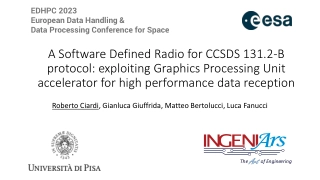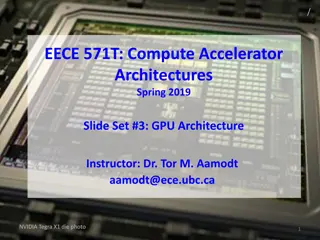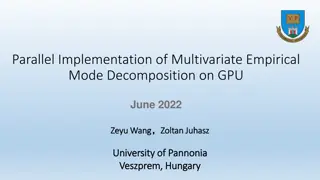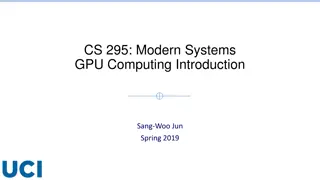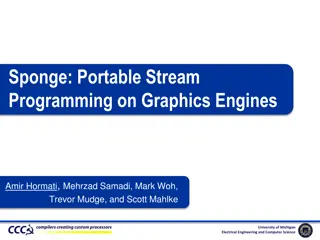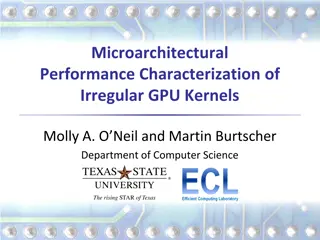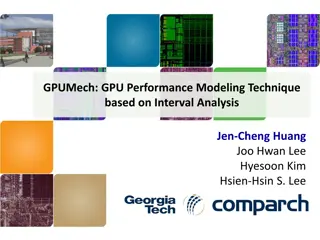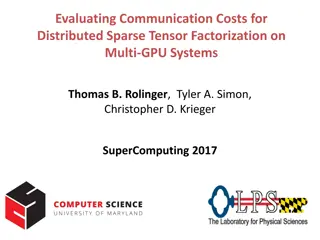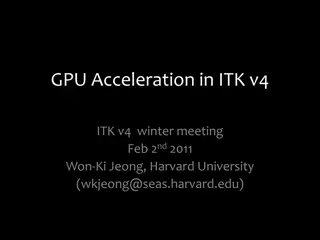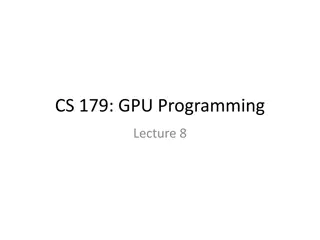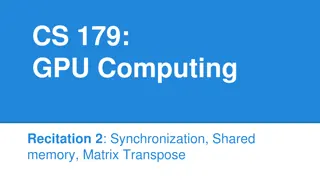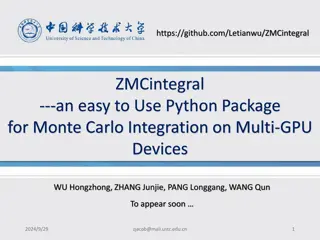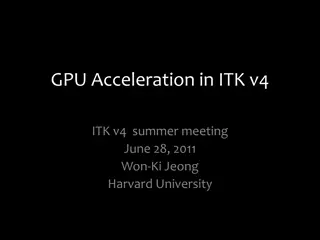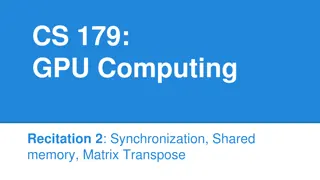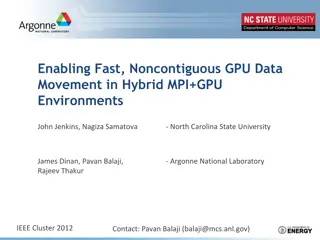
Enhancing Computing Efficiency with Graphics Processing Units (GPUs)
Explore how Graphics Processing Units (GPUs) are transforming computing by enabling exa-scale platforms and minimizing power per operation. Discover the specialized design of GPUs for high-intensity computation, their role in 3D graphics, and their potential as co-processors for compute-intensive tasks. Dive into the comparison between powerful CPUs and multiple less powerful CPUs, and understand the evolution of GPU and CPU performance over the years. Learn about CUDA architecture for NVIDIA GPUs and the Fermi generation's impact on computing efficiency.
Download Presentation

Please find below an Image/Link to download the presentation.
The content on the website is provided AS IS for your information and personal use only. It may not be sold, licensed, or shared on other websites without obtaining consent from the author. If you encounter any issues during the download, it is possible that the publisher has removed the file from their server.
You are allowed to download the files provided on this website for personal or commercial use, subject to the condition that they are used lawfully. All files are the property of their respective owners.
The content on the website is provided AS IS for your information and personal use only. It may not be sold, licensed, or shared on other websites without obtaining consent from the author.
E N D
Presentation Transcript
Why is GPU in the picture Seeking exa-scale computing platform Minimize power per operation. Power is directly correlated to the area in the processing chips. Regular CPU what are the chip areas going into? Power per operation is low How to maximize power per operation? Give most area to build lots of ALUs, minimize area for control and cache. This is how GPU is built power per operation is much better than regular CPU Most power efficient system built using CPU only, IBM Bluegene reaches 2Gflops/Watt System built using CPU+GPU can reach close to 4Gflops/Watt.
Graphics Processing Unit (GPU) GPU is the chip in computer video cards, PS3, Xbox, etc Designed to realize the 3D graphics pipeline Application Geometry Rasterizer image GPU development: Fixed graphics hardware Programmable vertex/pixel shaders GPGPU general purpose computation (beyond graphics) using GPU in applications other than 3D graphics GPGPU can be treated as a co-processor for compute intensive tasks With sufficient large bandwidth between CPU and GPU.
CPU and GPU GPU is specialized for compute intensive, highly data parallel computation More area is dedicated to processing Good for high arithmetic intensity programs with a high ratio between arithmetic operations and memory operations. ALU ALU Control ALU ALU Cache DRAM DRAM CPU GPU
Flop rate of CPU and GPU Single Precision Double Precision 1200 Tesla 20-series 1000 Tesla 10-series GFlop/Sec 800 Tesla 20-series 600 Tesla 8-series Westmere 3 GHz 400 Tesla 10-series Nehalem 3 GHz 200 0 2003 2004 2005 2006 2007 2008 2009 2010
Compute Unified Device Architecture (CUDA) Hardware/software architecture for NVIDIA GPU to execute programs with different languages Main concept: hardware support for hierarchy of threads
Fermi architecture First generation (GTX 465, GTX 480, Telsa C2050, etc) has 512 CUDA cores 16 stream multiprocessor (SM) of 32 processing units (cores) Each core execute one floating point or integer instruction per clock for a thread Latest Tesla GPU: Tesla K40 have 2880 CUDA cores based on the Kepler architecture. Warp size is still the same, but more everything. Kepler architecture: 15 SMX
Fermi Streaming Multiprocessor (SM) 32 CUDA processors with pipelined ALU and FPU Execute a group of 32 threads called warp. Support IEEE 754-2008 (single and double precision floating points) with fused multiply-add (FMA) instruction). Configurable shared memory and L1 cache
Kepler Streaming Multiprocessor (SMX) 192 CUDA processors with pipelined ALU and FPU 4 warp scheduler Execute a group of 32 threads called warp. Support IEEE 754-2008 (single and double precision floating points) with fused multiply-add (FMA) instruction). Configurable shared memory and L1 cache 48K data cache
SIMT and warp scheduler SIMT: Single instruction, multi-thread Threads in groups (or 16, 32) that are scheduled together call warp. All threads in a warp start at the same PC, but free to branch and execute independently. A warp executes one common instruction at a time To execute different instructions at different threads, the instructions are executed serially To get efficiency, we want all instructions in a warp to be the same. SIMT is basically SIMD that emulates MIMD (programmers don t feel they are using SIMD).
Fermi Warp scheduler 2 per SM: representing a compromise between cost and complexity
Kepler Warp scheduler 4 per SM with 2 instruction dispatcher units each.
NVIDIA GPUs (toward general purpose computing) ALU ALU Control ALU ALU Cache DRAM DRAM
Typical CPU-GPU system Main connection from GPU to CPU/memory is the PCI-Express (PCIe) PCIe1.1 supports up to 8GB/s (common systems support 4GB/s) PCIe2.0 supports up to 16GB/s
GPU as a co-processor CPU gives compute intensive jobs to GPU CPU stays busy with the control of execution Main bottleneck: The connection between main memory and GPU memory Data must be copied for the GPU to work on and the results must come back from GPU PCIe is reasonably fast, but is often still the bottleneck.
GPGPU constraints Dealing with programming models for GPU such as CUDA C or OpenCL Dealing with limited capability and resources Code is often platform dependent. Problem of mapping computation on to a hardware that is designed for graphics.

